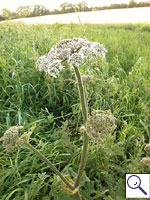|
||||||
|
HERACLEUM. Hogweeds. [Apiaceae] |
|
|
Three species of Heracleum are recorded in Britain. These include the native Hogweed (H. sphondylium) and Giant Hogweed (H. mantegazzianum). Twelve or thriteen British miners are recorded on Hearcleum. British records of Pegomya solennis (= versicolor) on Heracleum are discounted by Griffiths (1982) as probable misidentifications of the tephritid Euleia heraclei. The agromyzid Melanagromyza angeliciphaga is recorded boring stems of Heracleum and other Apiaceae in Britain and elsewhere. Elsewhere the agromyzid Liriomyza lutea is recorded feeding in the seed heads of Heracleum. Elsewhere the agromyzid Napomyza carotae is recorded on Apium. In larval transfer experiments in Switzerland found that the larvae of Napomyza carotae developed normally in Apium, Heracleum, Pastinaca and Petroselinum. A key to the European miners recorded on Heracleum is provided in Bladmineerders van Europa. |
|
Key for the identification of the known mines of British |
Note: Diptera larvae may live in a corridor mine, a corridor-blotch mine, or a blotch mine, but never in a case, a rolled or folded leaf, a tentiform mine or sandwiched between two more or less circular leaf sections in later instars. Pupation never in a cocoon. All mining Diptera larvae are leg-less maggots without a head capsule (see examples). They never have thoracic or abdominal legs. They do not have chewing mouthparts, although they do have a characteristic cephalo-pharyngeal skeleton (see examples), usually visible internally through the body wall. The larvae lie on their sides within the mine and use their pick-like mouthparts to feed on plant tissue. In some corridor miners frass may lie in two rows on alternate sides of the mine. In order to vacate the mine the fully grown larva cuts an exit slit, which is usually semi-circular (see Liriomyza huidobrensis video). The pupa is formed within the hardened last larval skin or puparium and as a result sheaths enclosing head appendages, wings and legs are not visible externally (see examples). See Key to non-Diptera. |
1# > Leaf-mine: Details of mine unknown. |
|
Melanagromyza limata Spencer, 1971 [Diptera: Agromyzidae]. |
1a > Stem miner: An external mine on stem or leaf stalk. Pupation either at leaf base or beneath epidermis of main stem (Spencer, 1972b: 31). |
|
Ophiomyia heracleivora Spencer, 1957 [Diptera: Agromyzidae]. |
1b > Leaf miner |
2b > Leaf miner: Mine not interparenchymal |
3a > Leaf miner: A regular greenish inter-parenchymal blotch mine, frequently delimited by two veins, appearing somewhat mottled as a result of small deeper areas of feeding through the upper parenchyma (Spencer, 1972b: 78 (fig. 259); Spencer, 1976: 428, 429 (fig. 748). The mine starts with a quite inconspicuous lower-surface corridor that soon changes into an extensive interparenchymatous blotch. The upper cell layer of the palisade parenchyma is eaten away in many places, giving the mine in transparency a perforated appearance. Fresh mines are pale green, later they turn brown; they give the leaves a strikingly diseased impression. Feeding lines absent, frass grains strikingly few. Larvae solitary. Pupation outside the mine, exit slit in lower epidermis. Forms a blotch mine between two veins, having a characteristic sieve-like appearance (where the larva has fed through the upper parenchyma). Pupation outside the mine.. |
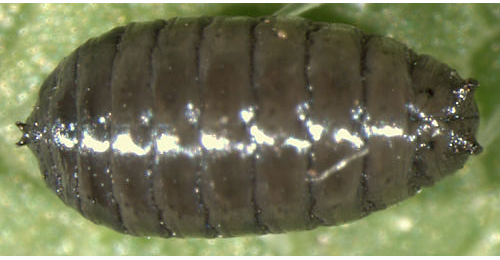 Phytomyza heracleana puparium Image: © Willem Ellis (Bladmineerders van Europa) |
|
Phytomyza heracleana Hering, 1937 [Diptera: Agromyzidae]. |
3b > Leaf miner: Mine inter-parenchymal, greenish-yellow, not always readily visible, an irregular linear-blotch (Spencer, 1972b: 78 (fig. 260)). Broad, irregular interparenchymatous corridor, here and there widening into a blotch; fairly inconspicuous. Frass grains few, irregularly scattered. Pupation outside the mine. The leaf discolours as the larva mines through the parenchyma of the leaf. The mine is inter-parenchymal, greenish-yellow, not always readily visible, an irregular linear-blotch. |
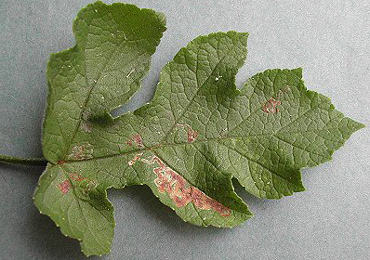 Mine of Phytomyza sphondyliivora on Heracleum Image: © Rob Edmunds (British leafminers) |
|
Phytomyza sphondyliivora Spencer, 1957 [Diptera: Agromyzidae]. |
3c > Leaf-miner: A distinctive mine primarily above mid-rib, with irregular short lateral offshoots into leaf blade. Pupation external (Spencer, 1972: 51 (fig. 172), 55; Spencer, 1976: 270, 271 (fig. 486)). Branched, whitish, upper-surface corridor; main axis overlying the midrib; side branches overlying the main lateral veins. (In Campanula and Phyteuma the mine is much less branched, sometimes nothing more than a corridor on top of the midrib). Frass in rather long strings. Usually the mines begins as a long and narrow, shallow, tortuous lower-surface corridor that ends upon the midrib but otherwise is not associated with the leaf venation. Often this initial corridor is filled with callus, and then even less conspicuous. Pupation outside the mine. A linear mine on the upper surface, usually following the midrib and showing side branches along the veins. The frass is in strings. |
|
Liriomyza strigata (Meigen, 1830) [Diptera: Agromyzidae]. |
4a > Leaf miner: A large blotch, yellow or brown, preceded by a short corridor that in the end mostly is completely overrun. Generally several larvae share a mine. Especially in fresh mines the green primary and secondary feeding lines are well visible. Pupation outside the mine. Puparium yellow. |
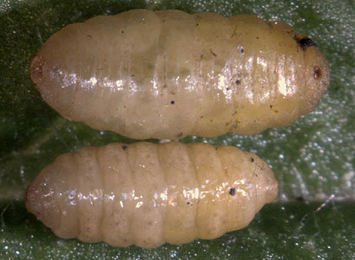 Euleia heraclei pupariria Image: © Willem Ellis (Bladmineerders van Europa) |
|
Euleia heraclei (Linnaeus, 1758) [Diptera: Tephritidae]. |
4b > Leaf miner: A large blotch, yellow or brown, preceded by a short, in the end mostly unrecognisable corridor. Generally several larvae in the mine. Especially in fresh mines the green primary and feeding lines area well marked. Pupation outside the mine. |
|
Cryptaciura rotundiventris (Fallén, 1814) [Diptera: Tephritidae]. |
4c > Leaf-miner: Larva forms an upper surface primary blotch with several larvae feeding together; the blotch is greenish when fresh but becomes yellowish with age (Spencer, 1972b: 78 (fig. 257); Spencer, 1976: 376, 377 (fig. 655)). Round or oval blotch, green at first, later yellowish. Young mine are interparenchymatous, only the older mines are truly full depth. Generally several larvae in a communal mine. Pupation outside the mine. Exit slit in lower epidermis. A conspicuous, yellowish, almost circular upper surface blotch. Normally several mines on a leaf which may run together giving the impression of a single mine. |
|
Phytomyza angelicae Kaltenbach, 1872 [Diptera: Agromyzidae]. |
4d > Leaf miner: Corridor mine. |
5 > Leaf miner: A conspicuous, whitish linear mine. Pupation external (Spencer, 1976: 506, 507 (fig. 886)). Long, upper-surface, frequently branched, little widening corridor; sides somehwat irregular. Often several mines in a leaf. Frass in grains that are placed close together, rarely forming short pearl chains. Pupation outside the mine, exit slit in lower epidermis. Sometime the puparium sticks to the leaf. Feeding punctures in lower epidermis. Larva forms a conspicuous, whitish linear mine. Larva leaves the mine through the lower surface and falls from the leaf on pupation. |
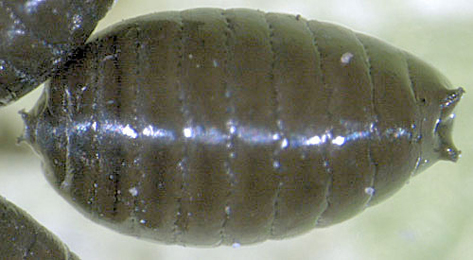 Phytomyza pastinacae / spondyli puparium Image: © Willem Ellis (Bladmineerders van Europa) |
|
Phytomyza
spondylii Robineau-Desvoidy, 1851 [Diptera: Agromyzidae] |
Key for the identification of the known mines of British |
Note: The larvae of mining Coleoptera, Hymenoptera and Lepidoptera may live in a corridor mine, a corridor-blotch mine, a blotch mine, a case, a rolled or folded leaf, a tentiform mine or sandwiched between two more or less circular leaf sections in later instars. Larva may pupate in a silk cocoon. The larva may have six legs (although they may be reduced or absent), a head capsule and chewing mouthparts with opposable mandibles (see video of a gracillarid larva feeding). Larvae of Hymenoptera and Lepidoptera usually also have abdominal legs (see examples). Frass, if present, never in two rows. Unless feeding externally from within a case the larva usually vacates the mine by chewing an exit hole. Pupa with visible head appendages, wings and legs which lie in sheaths (see examples). |
1a > Leaf-miner: In the first instar the larva mines the leaves, forming short, irregular, blotch-like mines, but in later instars it lives externally, feeding in spun leaves and often twisting those of tender shoots. Larval head light-brown or yellowish brown, edged with black postero-laterally, ocellar area blackish; prothoracic plate black edged with whitish anteriorly; abdomen dull dark green; pinacula distinct, black, sometimes brownish but with black bases to setae; anal plate large, black (Bradley et al., 1973). Small, full depth mine without a definite shape; little frass. Some silk is deposited in the mine. The larva soon leaves the mine and continues feeding among spun leaves. |
|
Cnephasia incertana (Treitschke, 1835) [Lepidoptera: Tortricidae]. |
1b > Leaf miner: The larvae are often gregarious and feed on the underside of the leaf causing a 'windowing' effect as they eat the mesophyll and lower epidermis. This effect can be seen from the top of the leaf as it discolours. Short, small, irregular, sometimes widened corridor. Mostly a number in a leaf, concentrated in the axils of the midrib and the primary side veins. Each larva makes a number of mines. Often the larva protrudes with its rear end out of the mine, causing most frass to be ejected. While moving, at the leaf underside, silken threads are produced, in wich grains of frass may be trapped. Older larvae live free and cause window feeding, often in a group under a light spinning. |
|
Epermenia chaerophyllella (Goeze, 1783) [Lepidoptera: Epermeniidae]. |
| Last updated 05-Jul-2019 Brian Pitkin | ||

